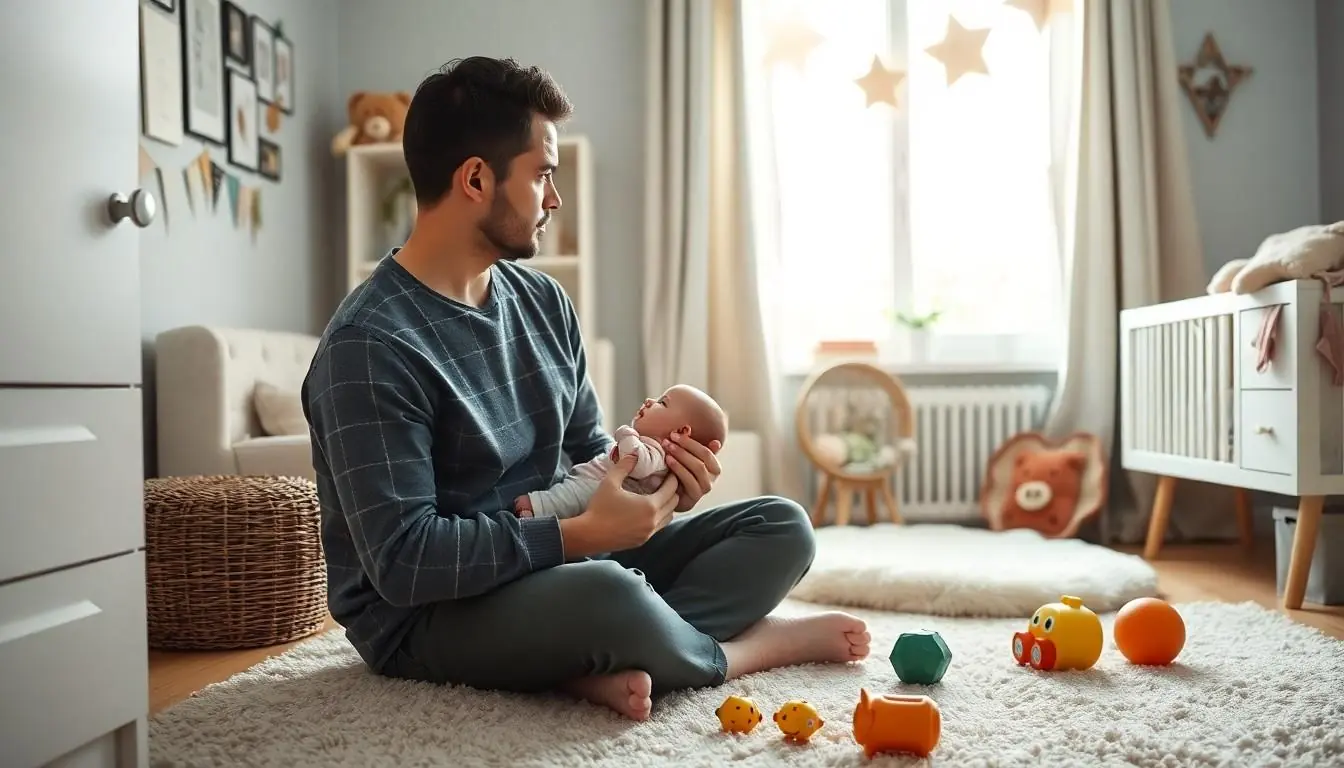Imagine a world where your baby’s favorite blanket isn’t a secret stash of nicotine and other nasty surprises. Thirdhand smoke, the invisible residue left behind by smoking, clings to surfaces and fabrics, turning cozy baby nurseries into unintentional toxic zones. It’s like a game of hide and seek, but instead of finding toys, parents might stumble upon harmful chemicals lurking in their little one’s environment.
As if parenting isn’t challenging enough, the dangers of thirdhand smoke can sneak in without a warning. Babies are particularly vulnerable, with their tiny lungs and curious hands exploring everything in sight. Understanding the risks and taking action can help create a safer space for your child. Let’s dive into the world of thirdhand smoke and discover how to keep your baby’s environment fresh, clean, and free from those sneaky smoke residues.
Table of Contents
ToggleUnderstanding Third Hand Smoke
Thirdhand smoke is the residue created by tobacco smoke that settles on surfaces and materials after smoking has occurred. This residue can linger long after smoking stops, transforming environments into potentially harmful spaces for infants.
Definition and Sources
Thirdhand smoke consists of harmful chemicals that remain on household surfaces, clothing, carpets, and toys. Sources include cigarettes, cigars, and pipes. It originates from the smoke exhaled by smokers, as well as from the burning tobacco product itself. Notably, nicotine and other toxins remain for extended periods, even in areas where smoking hasn’t occurred recently. Regular cleaning doesn’t eliminate this risk entirely, as residue can stick tightly to fibers and surfaces.
Impact on Health
Health risks associated with thirdhand smoke are significant, especially for babies who explore their environments. Infants often crawl and put objects in their mouths, increasing their exposure to these toxic residues. Studies indicate that thirdhand smoke can contribute to respiratory issues, allergies, and developmental problems in young children. Vulnerable populations, like babies, are particularly at risk due to their developing systems. Parents and caregivers must recognize these dangers to mitigate exposure and protect children’s health effectively.
Effects of Third Hand Smoke on Babies

Thirdhand smoke poses significant health risks to babies, affecting their delicate systems. This residue contains harmful toxins that can influence infants in various ways.
Inhalation Risks
Inhaling thirdhand smoke can lead to respiratory issues in babies. They are more vulnerable due to their developing lungs. Research indicates that exposure can trigger asthma-like symptoms, such as wheezing and coughing. Prolonged exposure may contribute to chronic respiratory diseases later in life. Infants often breathe deeply while sleeping, increasing the likelihood of inhaling harmful particles. The danger escalates in poorly ventilated areas, where toxic substances linger longer. Preventing exposure in nurseries significantly reduces these risks.
Skin Contact and Ingestion
Skin contact with thirdhand smoke can cause adverse health effects in babies. Their sensitive skin absorbs harmful chemicals present in the residue, potentially leading to rashes and irritations. Ingesting contaminated objects poses another risk. Infants frequently explore their surroundings by putting items in their mouths, making them susceptible to toxin ingestion. Studies show that even low levels of exposure can lead to developmental issues, emphasizing the need for a smoke-free environment. Maintaining clean surfaces and toys is crucial in protecting babies from the dangers of thirdhand smoke.
Prevention Strategies for Parents
Maintaining a safe environment for babies requires specific actions to prevent thirdhand smoke exposure. Parents can implement targeted strategies to create a healthier space.
Creating a Smoke-Free Environment
Establishing a smoke-free home significantly reduces risks associated with thirdhand smoke. Designate areas in the home as completely smoke-free, ensuring that no one can smoke inside. Moving smoking outdoors limits the likelihood of residue settling onto furniture or carpets. Additionally, keeping windows open while cleaning allows for better ventilation, helping to remove any lingering contaminants. Incorporating a no-smoking policy into family events and gatherings further reinforces this commitment to health. Clean surfaces, carpets, and upholstery regularly, as contaminants can cling to them.
Educating Relatives and Friends
Educating family members and friends about the dangers of thirdhand smoke is crucial. Sharing information on how harmful residues can affect infants encourages them to support a smoke-free environment. Discussing specific risks, such as respiratory issues and developmental delays, can enhance their understanding. Providing resources and studies on the topic fosters a sense of urgency. Role-playing scenarios where guests can refuse to smoke in designated areas promotes proactive behavior. Engaging in open conversations about smoke-free policies sets clear expectations for families visiting with babies. Empowering loved ones to prioritize children’s health helps build a protective network.
Current Research and Findings
Current research demonstrates the significant dangers of thirdhand smoke, particularly for infants. This residue can permanently settle on various surfaces and pose serious health risks.
Studies on Thirdhand Smoke
Numerous studies confirm that thirdhand smoke contains toxic compounds, including lead and cadmium, detrimental to developing babies. Research from the American Journal of Respiratory and Critical Care Medicine indicates that low-level exposure to thirdhand smoke correlates with increased respiratory issues in children. Furthermore, a 2021 study published in Pediatrics highlights that infants exposed to thirdhand smoke exhibit a higher prevalence of asthma symptoms and impaired lung function. These findings underscore the importance of minimizing thirdhand smoke exposure in infants’ environments.
Case Studies Involving Babies
Case studies have shed light on the specific impacts of thirdhand smoke on infants. One notable study involved a cohort of babies from homes with smokers. Researchers observed these infants for respiratory illnesses over several months, finding a marked increase in asthma-like symptoms among those exposed. Another case study documented skin irritations among infants frequently in contact with surfaces contaminated by thirdhand smoke. These real-world scenarios emphasize the need for protective measures, as even indirect exposure has significant health implications for vulnerable babies.
Thirdhand smoke poses serious risks to babies who are particularly vulnerable to its harmful effects. By understanding the dangers associated with this invisible residue, parents and caregivers can take proactive steps to create a safer environment. Implementing smoke-free policies and maintaining clean surfaces are essential in protecting infants from potential health issues. Awareness and education about the risks of thirdhand smoke can empower families to prioritize their children’s well-being. By fostering a smoke-free atmosphere, they can help ensure a healthier future for their little ones.


